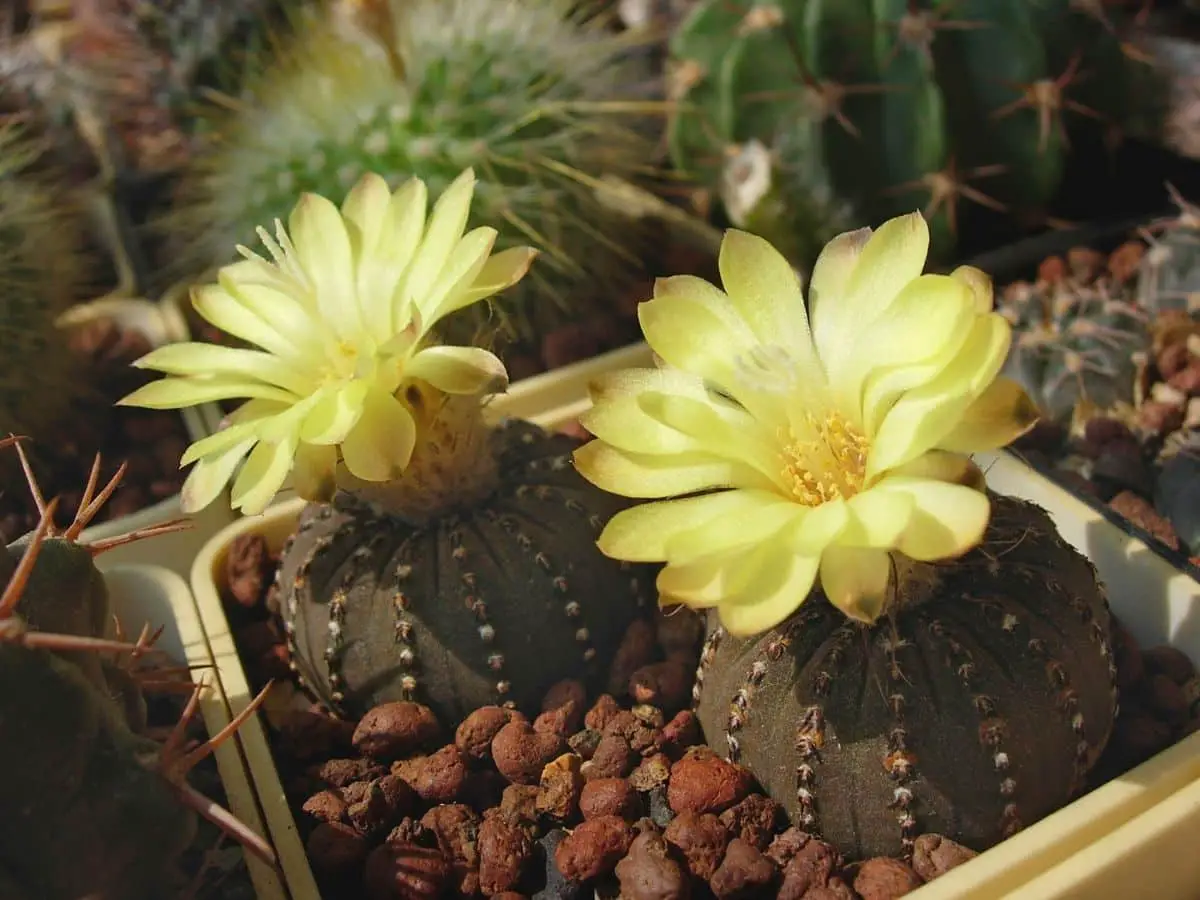Frailea cacti include a range of cactus species that are generally quite small in growth. These cute little plants are ideal for growing in pots indoors where they require minimal care.
Flowering in cultivation is quite rare but if you’re lucky enough to see one in flower, you’ll be pleasantly delighted by the spectacular display.
The flowers are usually larger than the plant itself and range in color from cream to yellow. Interestingly, these flowers are cleistogamous which means that they can produce fruit and seed even without opening.
In general, these cacti are solitary and have a flattened dome structure. These dome-shaped stems have ribs that are covered with fine spines around the edges.
Depending on the species, the stems can be either green, reddish-green, or chocolate. The fuzzy white fruit develops into a fragile capsule that is filled with large seeds.
History
Originally, these plants were classified into the genus Echinocactus back in 1838. However, in 1922, Britton and Rose created the genus Frailea for these dainty plants.
This was in honor of Manuel Fraile, who spent many years as a curator, looking after the US Department of Agriculture’s cactus collection.
Plant Facts
| Scientific name | Frailea spp. |
| Common names | Unknown |
| Genus | Frailea |
| Family | Cactaceae |
| Height | 1 to 2 inches |
| Width | 2 inches |
| USDA Plant Hardiness Zone | 10 to 12 |
| Origin | Brazil, Argentina, Paraguay, Uruguay, Bolivia |
| Flower colors | Cream, Yellow |
| Blooming season | Summer |
| Plant/Flower special features | When there is insufficient water available, the plant will often disappear into the soil and re-emerge when its given water. |
How to Plant and Grow Frailea Cacti
These cacti can live quite happily in small pots indoors. You don’t need to repot very often, only once every few years, because the plant does not grow very large.
These little cacti can even be grown together in a display in the same pot because they don’t mind being crowded.
How to Propagate Frailea Cacti
The best way to propagate cacti is by using seeds as they germinate quickly and easily. However, bear in mind that this plant is quite slow-growing, so it could take some time for germinated seedlings to reach a decent size.
As these cacti don’t live too long – rarely more than 10 to 15 years – it’s a good idea to continue propagating new ones when you have some seeds available. Older plants do have a tendency to just die suddenly.
Once you harvest the seeds, just put them in a good succulent mix and keep them moist. Young seedlings don’t like strong light or being allowed to dry out.
Care and Maintenance
These delightful little plants are very easy to look after as long as you don’t overwater them.
They require regular watering in summer but wait for the soil to dry out before giving your plant another drink. Other than just a little fertilizer over summer, these plants don’t need any additional care.
Soil
It’s best to use a free-draining cactus or succulent mix for your Frailea cactus.
Water
Like most cacti species, these plants prefer to have their soil dry before more water is added. During summer, when the plant is actively growing, give it a good drink once a week. However, in spring and fall, the plant only needs to be watered once every three weeks. In winter, it becomes dormant and, therefore, doesn’t require watering.
Fertilizer
In summer, give your cactus some diluted cactus fertilizer once a month. This is enough to ensure healthy growth over the warmer months.
Sunlight
These plants prefer to grow in full sunlight. However, if you want to grow them inside, don’t place them directly on a sunny windowsill. The strength of the sunlight through the glass can burn the fleshy stem.
Temperature and Humidity
These little plants do not tolerate frost or really cold temperatures. They prefer to be kept warm and grown indoors except if you live in USDA zones above 10.
Pruning
These plants don’t require pruning.
Pest and diseases
Healthy plants are quite pest and disease resistant as long as you don’t overwater them. You might want to keep an eye out for normal houseplant pests such as mealybugs, scale, and red spider mites. These can easily be controlled with a cotton swab dipped in alcohol.
Uses of Frailea Cacti
These plants are mainly grown for their ornamental value. They can even be grouped together in the same planter to create an interesting display. Just make sure the planter you choose has good drainage holes as these plants should never be allowed to sit in water.
Common Varieties and Cultivars
There are quite a large number of species in the Frailea genus. However, not all of these have been accepted, are actually cataloged, or are available in cultivation.
Here is a list of Frailea varieties that you should be able to add to your collection:
- F. mammifera
- F. castanea
- F. pumila
- F. cataphracta
- F. phaeodisca
- F. grahliana
- F. buenekeri
- F. asterioides
- F. angelesii
- F. altasensis
- F. chiquitana
- F. curvispina
- F. friedrichii
- F. gracillima
- F. grahliana
- F. knippeliana
- F. perumbilicata
- F. pseudopulcherrima
- F. pygmaea
- F. schilinzkyana
Conclusion
Frailea cacti are cute little plants that are easy to grow, don’t take up a lot of space and can easily be grown indoors. There are quite a large number of species in this genus but not all of them are available for cultivation. Nevertheless, you should be able to find plenty of species to get your collection started.
*image by Adaco/depositphotos

